
TARTALOM
What do we mean by the regular period and what other periods do we differentiate from that period?
Noticeable decrease - the relation of the year-end traffic with the traffic calming objectives
How do we collect road-related data in Budapest?
Examination of year-end road traffic data
What are the characteristics of the road traffic flow on the working days preceding the last working day of the week?
What are the characteristics of the road traffic flow on the last working days of the week?
What are the characteristics of the road traffic flow on Sundays and on public holidays?
Public transport is available on a continuous basis even during the year-end period
Year-end traffic differs from the other periods of the year that can be noticed by everyone. Road transport is not an exemption, either to this principle. BKK Centre for Budapest Transport follows with particular attention the transport characteristics of even the busy periods, thus periodical travel habits could be known in a deeper way and adjusted data-based decisions could be made.
What are the characteristics of the road traffic volume in the year-end period? What are the characteristics of the road traffic flow on certain days and how are these related to the regular period? What are the typical road traffic that we can expect during the year-end period? Please find our answers to these questions in the below-described summary.
What do we mean by the regular period and what other periods do we differentiate from that period?
In terms of road traffic, we consider the base period the average of the time interval when natural traffic flow of the spring or autumn school term is not intervened by a public holiday or a replacement rest day.
A given year has various special periods when there are lower or higher traffic volume on the roads, compared to the previously-described base period.
Here are some examples:
- Sundays in the summertime are characterised by these features, particularly on the joint section of the M1 and M7 motorways. During these periods, traffic volume significantly increases, especially on motorway M7, due to the effect of road users heading towards Budapest from the direction of Lake Balaton. Traffic volume begins to accelerate already in the morning and gradually rises until the early evening. On a summer Sunday, 12% more vehicles go through the entry point of motorway M1/M7 than on an average Sunday.
- Long weekends are considered to be special periods as well. During these periods we can perceive less vehicle transit.
- The period preceding the All Souls’ Day generates a peculiar vehicle traffic. While traffic decreases in general, the higher traffic volume is concentrated in hot-spot areas, in that case, in the vicinity of cementeries. Major events, such as the Sziget Festival organised in summer, the Formula-1 Hungarian Grand Prix, sports events and concerts held in the larger concert venues generate such particular traffic, as you can also read in the blog titled.
However, except for the listed periods with unique traffic volume, there is a longer period with special characteristics, that is the year-end, Advent, Christmas and new year-period, each having different traffic-related features.
Noticeable decrease - the relation of the year-end traffic with the traffic calming objectives
As we have already mentioned in the introduction, the rate of road traffic is appreciably lower during the year-end holiday season, especially in the weekday morning peak hours. We illustrate this phenomenon below in detail on charts with traffic data.
As a result of the traffic decrease - generated particularly during weekday morning peak hours, there is practically no congestion at all, especially during the two holidays. As we measure a significantly lower value on year-end public holidays, compared to the value of an average Sunday, therefore we can talk about a completely smooth traffic on the roads of the Hungarian capital on these days.
If we play with the following thought: “What would be the case if this was the general traffic flow?”, then it is worthwhile to examine in a quantifiably way how much decrease it would mean. The weekday daily traffic between the two holidays is lower circa by 20% than in the normal period, while this value is 60% in the morning peak hours, which is a significant decrease.
The Budapest Mobility Plan has set the objective to decrease car traffic by 15% by 2030, compared to the current daily traffic. It can be visible that this value on the weekdays between the two holidays is 20%, thus it would be sufficient to only slightly decrease the traffic flow compared to the year-end traffic to achieve this objective and to significantly mitigate the number and rate of congestions in the future, as we can see that during the above-mentioned period it is much easier to get about on Budapest’s roads.
How do we collect road-related data in Budapest?
Hundreds of inductive loop detectors installed in the carriageways, as well as traffic counter cameras provide information about road transport. The operation of these devices pertains to Budapest Közút (Budapest Public Roads), however at BKK, several analyses are made out of the data recorded by these devices.
The device, whose operation is based on the analysis of the inductive loop detector and the camera images measures identical data: The traffic value passing through a given cross-section as well as the average cross-sectional speed derived from the occupancy. Among the two devices, the processing made by the camera is more accurate, however cameras react to the changes of their surroundings more sensibly and are more costly, than the inductive loop detectors.
Please visit BKK’s subpage titled Traffic data, charts for further traffic-related data, which are registered, among others, by the above-described loop detectors and cameras.
In the schematic map you can find the location of the loop detectors used for the analysis.
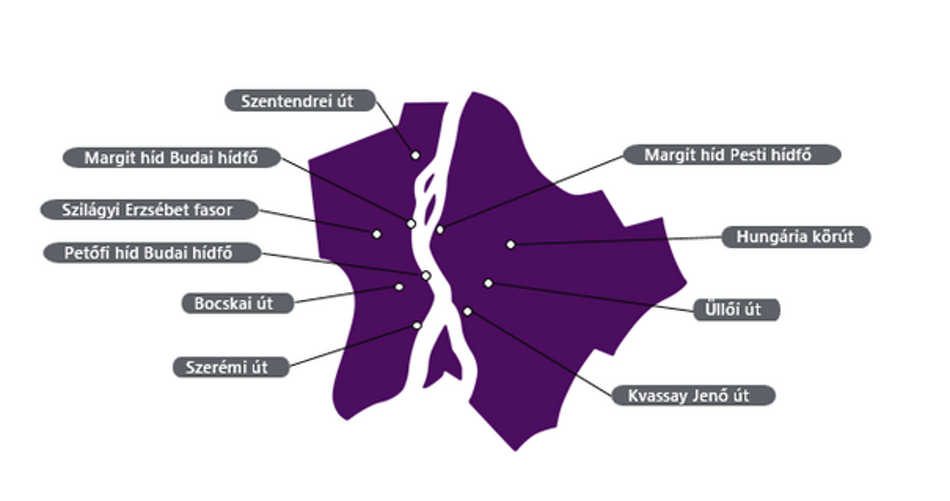
Examination of year-end road traffic data
What are the characteristics of the road traffic flow on the working days preceding the last working day of the week?
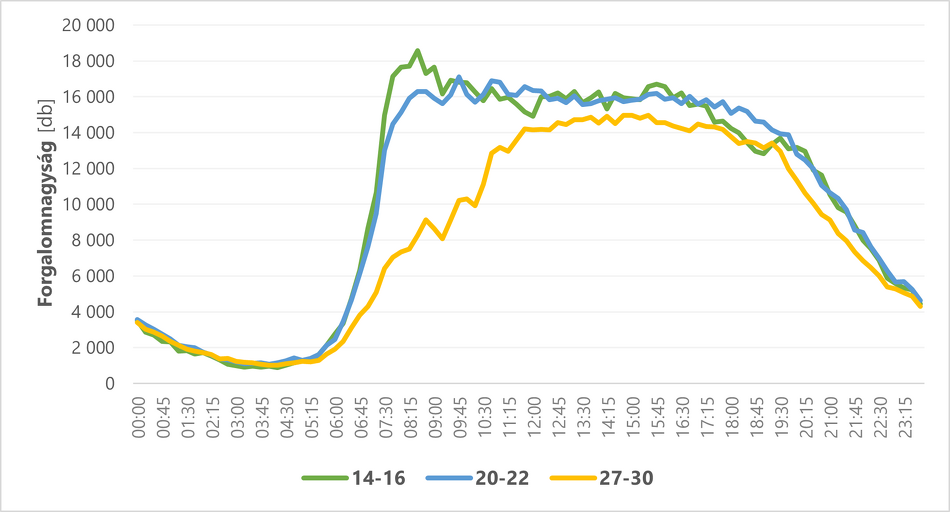
On the above figure, traffic of the year-end period of 2021 is illustrated per day. Days between 14-16 (Tuesday - Thursday) December are the base for reference. The traffic on that day is considered normal, with the presence of a more significant morning peak following the quick morning rise and a weaker afternoon peak, following a relatively strong daytime period.
In comparison, the peak was approximately 10% lower in the mornings of the period of 20 - 22 December (Tuesday-Thursday) (the week of Christmas Eve During the daytime, the two traffic flows were quite similar, however the early evening traffic was higher between 20 and 22 December, which can be attributable to the increasing Christmas shopping demands.
Between 27-30 December (Monday-Thursday) between the Christmas and New Year’s Eve, traffic was significantly lower than on an average week. The entire daily traffic volume is approximately 80% of an average working day, while this value is approximately 40% in the morning peak hours. By examining the traffic flow, practically there is no peak in the morning and traffic is similar to a typical Saturday traffic.
What are the characteristics of the road traffic flow on the last working days of the week?
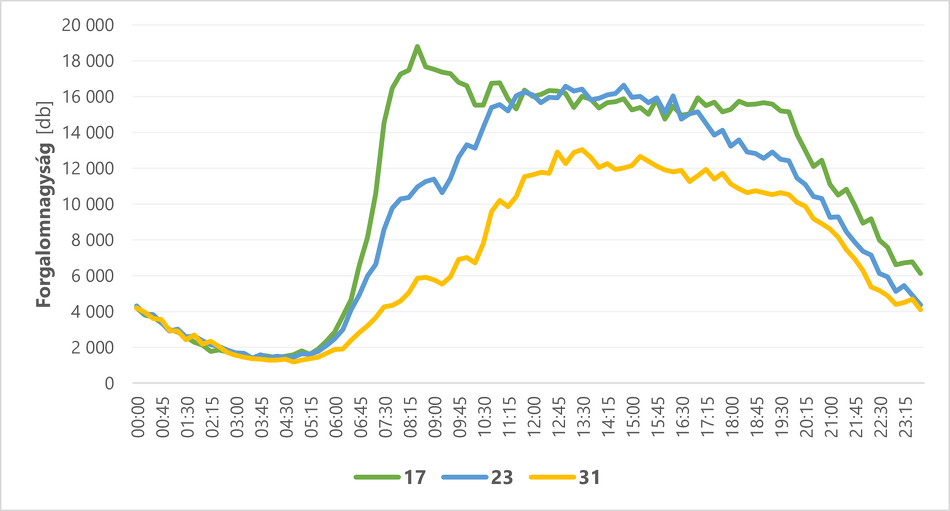
On the figure above, traffic of the year-end period of 2021 is illustrated per day. 17 December (Friday) is the base for reference. During That day, traffic is considered to be normal, with the presence of a more significant morning peak following the quick morning rise and a weaker afternoon peak, following a relatively strong daytime period. At the same time, the daily total traffic is higher, compared to an average period lasting from Monday to Thursday, typically in the afternoons, as a result of the vehicles leaving the city.
On 23 December, there is a minimal morning peak and after a drop, traffic starts to increase again. During the daytime, there is no decrease, as traffic is generated due to shopping. However, the late afternoon and evening traffic is below the usual traffic of this period and there is no afternoon peak, either.
On 31 December, Traffic on New Year’s Eve – compared to an average Friday working day – daytime, particularly morning traffic is extremely low. Even the evening road traffic is lower than the usual traffic typical in this period. The reason is that during New Year’s Eve, passengers use public transport frequently and traffic is distributed before midnight. On the following night, an increase can be found in road traffic, whose reason presumably is that more passengers use taxi services on the way home.
What are the characteristics of the road traffic flow on Sundays and on public holidays?
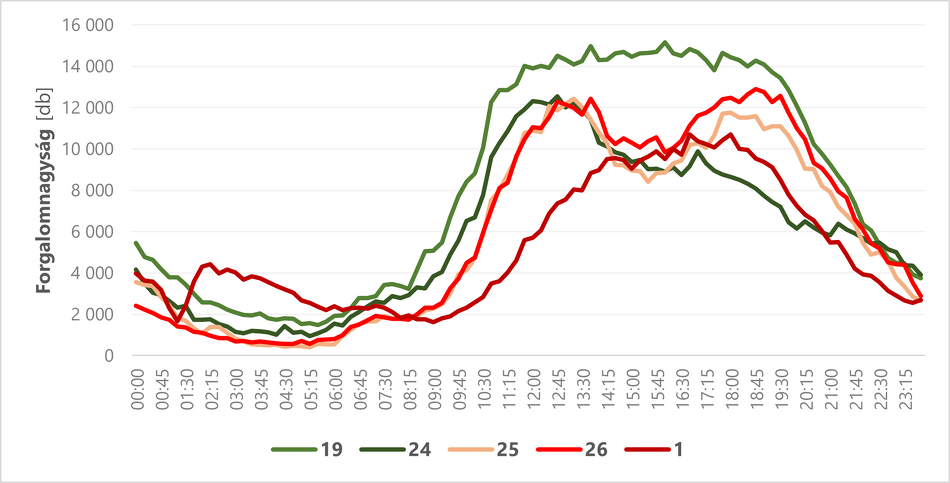
On the above figure, the traffic of the year-end holiday period of 2021 is illustrated per day. A Sunday on 19 December sets the basis for reference. The average Sunday traffic is composed of a rise in traffic flow generated at a later phase than on weekdays, a stagnated afternoon and a gradually decreasing tendency in the evening period.
On 24 December, the first peak is generated around noon with lower number of vehicles. The peak of traffic flow is adjusted to the opening hours of stores closing, which typically close around 12-1 pm on that day due to the holiday season. We can observe a decreasing number of vehicles after the first peak, which differs significantly from a Sunday traffic flow. The second peak is minimal on this day, as people seek to prepare for Christmas Eve. The number of vehicles fleet is are approximately 72% lower, compared to a normal Sunday.
The daily traffic flows On 25 and 26 December, are quite alike, also they are similar, to an average weekday flow with lower outliers The noonish peak traffic is generated later compared to the 24 December traffic flow. Between the two peaks, there is a drop during the daytime, following an outlier that can be the result of the flow of people who visit their loved ones to celebrate Christmas. The afternoon peak nears the Sunday tendency, however the number of the daily transits is 73% of that of the Sunday.
On 1 January, between approximately midnight and 1 am, the rate of road traffic is identical to an average Sunday traffic. The reason of that is the fact that at midnight and during the following hours, people do not really take trips. Afterwards, traffic suddenly increases and remains larger until 6-7 am than on an average Sunday. However, the morning rising phase is generated much later than usually; traffic is practically not increasing until approximately 9 am. The lowest traffic of the year is generated on 1 January, until the early afternoon period.
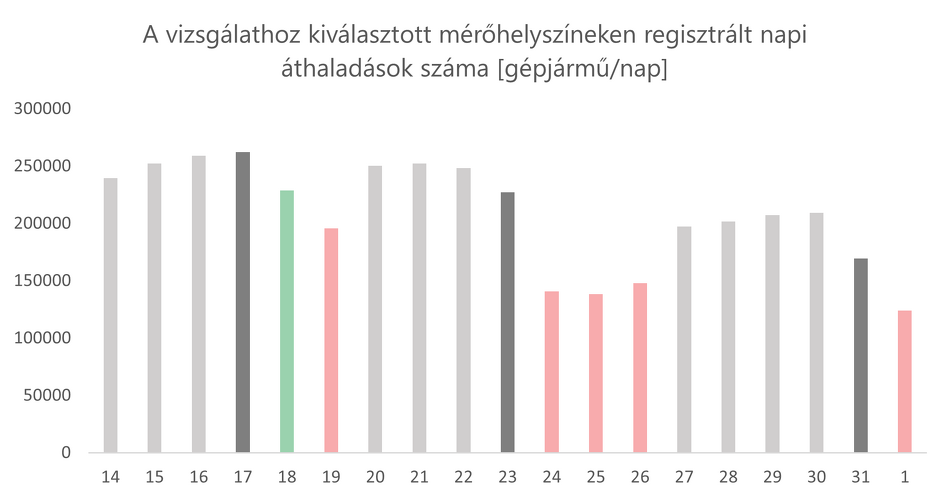
On the week before Christmas Eve, the weekday, daily total traffic was similar to that of the week of the Christmas Eve, and only a slight difference was considered in the daily flow (see above figure).
During the examined period, 17 December (Friday) was the day with the heaviest traffic, while one week later, on 23 December, road traffic was much lower. Between 14 and 22 December, we measured values very similar to weekday average values measured in November, 2021, while 23 December was even lower. On 18 and 19 December, during the last Advent weekend, the rate of road traffic was slightly higher than the November average values in 2021.
By examining the Christmas period (24-26 December), it can be seen that traffic in the Christmas period was approximately 2/3 of the previous Advent weekend traffic due, to the closure of stores.
Between the Christmas time and New Year’s Eve, traffic of the workdays was 20% lower than on an average week. On 31 December, we measured an even stronger drop and the daily total traffic did not reach the 18 December (Sunday) traffic level, either.
The day with the least traffic of that examined period and also the year was on 1 January. That day, the rate of road traffic did not even reach the level of the Christmas traffic.
It can be perceived in reality and seen on the above chart how diverse the year-end traffic flow is both in terms of daily total traffic and the daily traffic flow. The common feature is the low traffic volume, particularly in the peak hours.
Public transport is available on a continuous basis even during the year-end period
We should not forget about public transport, which is available on a continuous basis to all customers in Budapest even during this period, adjusted to the actual demands, while, for example in London, no public transport service operates on 25 December. While night services are in operation on Christmas Eve from approximately 4 pm, on New Year’s Eve, night services run more frequently.
Despite the low road traffic, it is worthwhile to continue choosing public transport, which operates in the year-end period with lower passenger flow.
Márku Martin
Senior Traffic Data Analyst at BKK. As a Traffic Engineer, he has set himself the goal of integrated transport development in the capital and increasing the efficiency of mobility in Budapest. Martin specialises in road transport, but also contributes to the implementation of public transport and micromobility projects. He is actively involved in the continuous service extension of the 100E airport shuttle bus and in the monthly transport reports.
Tóth Emma
Transport Engineering BSc student at the Budapest University of Technology and Economics. As a Trainee at BKK, she is involved in data processing and related data-driven decision making in all transport sectors. Emma’s goal is to develop a sustainable, integrated and coherent public transport system



